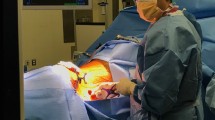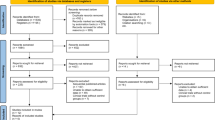Abstract
Purpose
Although pediatric spinal deformity correction using pedicle screws has a very low rate of complications, the long-term consequences of screw malposition is unknown. CT navigation has been proposed to improve screw accuracy. The aim of this study was to determine whether intraoperative navigation during pedicle screw placement in pediatric scoliosis makes screw placement more accurate. We also examined radiation exposure, operative time blood loss and complications with and without the use of CT navigation in pediatric spinal deformity surgery.
Methods
A systematic review of the literature was conducted. After screening, 13 articles were qualitatively and quantitatively analyzed to be used for the review. A random effects meta-analysis using REML methodology was employed to compare outcomes of screw accuracy, estimated blood loss, radiation exposure, and surgical duration.
Results
Screws placed with CT navigation surgery were three times as likely to be deemed “acceptable” compared with screws placed with freehand and 2D fluoroscopy assistance, twice as likely to be “perfect”, and only 1/3 as likely to be potentially unsafe (all p value < 0.01). EBL was not significantly different between groups; however, operative time was roughly thirty minutes longer on average. Random effects analysis showed no significant difference in effective dose radiation while using CT navigation (p = 0.06).
Conclusion
This systematic review of the literature demonstrates that intraoperative navigation results in more accurate pedicle screw placement compared to non-navigated techniques. We found that blood loss was similar in navigated and non-navigated surgery. Operative time was found to be approximately a half hour longer on average in navigated compared to non-navigated surgery. Effective radiation dose trended higher in navigated cases compared to non-navigated cases but did not reach statistical significance.







Similar content being viewed by others
References
Weinstein SL, Dolan LA, Cheng JC, Danielsson A, Morcuende JA (2008) Adolescent idiopathic scoliosis. Lancet 371(9623):1527–1537. https://doi.org/10.1016/S0140-6736(08)60658-3 (published Online First: Epub Date)
Chan A, Parent E, Narvacan K, San C, Lou E (2017) Intraoperative image guidance compared with free-hand methods in adolescent idiopathic scoliosis posterior spinal surgery: a systematic review on screw-related complications and breach rates. Spine J 17(9):1215–1229. https://doi.org/10.1016/j.spinee.2017.04.001 (published Online First: Epub Date)
Ascani E, Bartolozzi P, Logroscino CA et al (1986) Natural history of untreated idiopathic scoliosis after skeletal maturity. Spine (Phila Pa 1976) 11(8):784–789. https://doi.org/10.1097/00007632-198610000-00007 (published Online First: Epub Date)
Valic M, Zizek D, Span M, Mihalic R, Mohar J (2020) Malpositioned pedicle screw in spine deformity surgery endangering the aorta: report of two cases, review of literature, and proposed management algorithm. Spine Deform 8(4):809–817. https://doi.org/10.1007/s43390-020-00094-5 (published Online First: Epub Date)
Liu Z, Jin M, Qiu Y, Yan H, Han X, Zhu Z (2016) The Superiority of Intraoperative O-arm navigation-assisted surgery in instrumenting extremely small thoracic pedicles of adolescent idiopathic scoliosis: a case-control study. Medicine (Baltimore) 95(18):e3581. https://doi.org/10.1097/MD.0000000000003581 (published Online First: Epub Date)
Heidenreich M, Baghdadi YM, McIntosh AL et al (2015) At what levels are freehand pedicle screws more frequently malpositioned in children? Spine Deform 3(4):332–337. https://doi.org/10.1016/j.jspd.2014.12.003 (published Online First: Epub Date)
Jin M, Liu Z, Liu X et al (2016) Does intraoperative navigation improve the accuracy of pedicle screw placement in the apical region of dystrophic scoliosis secondary to neurofibromatosis type I: comparison between O-arm navigation and free-hand technique. Eur Spine J 25(6):1729–1737. https://doi.org/10.1007/s00586-015-4012-0 (published Online First: Epub Date)
de Broucker T, Pontana F, Santangelo T et al (2012) Single- and dual-source chest CT protocols: levels of radiation dose in routine clinical practice. Diagn Interv Imaging 93(11):852–858. https://doi.org/10.1016/j.diii.2012.07.009 (published Online First: Epub Date)
Ughwanogho E, Patel NM, Baldwin KD, Sampson NR, Flynn JM (2012) Computed tomography-guided navigation of thoracic pedicle screws for adolescent idiopathic scoliosis results in more accurate placement and less screw removal. Spine (Phila Pa 1976) 37(8):E473–E478. https://doi.org/10.1097/BRS.0b013e318238bbd9 (published Online First: Epub Date)
Cui G, Wang Y, Kao TH et al (2012) Application of intraoperative computed tomography with or without navigation system in surgical correction of spinal deformity: a preliminary result of 59 consecutive human cases. Spine (Phila Pa 1976) 37(10):891–900. https://doi.org/10.1097/BRS.0b013e31823aff81 (published Online First: Epub Date)
Su AW, Luo TD, McIntosh AL et al (2016) Switching to a pediatric dose O-arm protocol in spine surgery significantly reduced patient radiation exposure. J Pediatr Orthop 36(6):621–626. https://doi.org/10.1097/BPO.0000000000000504 (published Online First: Epub Date)
Urbanski W, Jurasz W, Wolanczyk M et al (2018) Increased radiation but no benefits in pedicle screw accuracy with navigation versus a freehand technique in scoliosis surgery. Clin Orthop Relat Res 476(5):1020–1027. https://doi.org/10.1007/s11999.0000000000000204 (published Online First: Epub Date)
Sakai Y, Matsuyama Y, Nakamura H et al (2008) Segmental pedicle screwing for idiopathic scoliosis using computer-assisted surgery. J Spinal Disord Tech 21(3):181–186. https://doi.org/10.1097/BSD.0b013e318074d388 (published Online First: Epub Date)
Tormenti MJ, Kostov DB, Gardner PA, Kanter AS, Spiro RM, Okonkwo DO (2010) Intraoperative computed tomography image-guided navigation for posterior thoracolumbar spinal instrumentation in spinal deformity surgery. Neurosurg Focus 28(3):E11. https://doi.org/10.3171/2010.1.FOCUS09275 (published Online First: Epub Date)
Baky FJ, Milbrandt T, Echternacht S, Stans AA, Shaughnessy WJ, Larson AN (2019) Intraoperative computed tomography-guided navigation for pediatric spine patients reduced return to operating room for screw malposition compared with freehand/fluoroscopic techniques. Spine Deform 7(4):577–581. https://doi.org/10.1016/j.jspd.2018.11.012 (published Online First: Epub Date)
Zhao Z, Liu Z, Hu Z et al (2018) Improved accuracy of screw implantation could decrease the incidence of post-operative hydrothorax? O-arm navigation vs. free-hand in thoracic spinal deformity correction surgery. Int Orthop 42(9):2141–2146. https://doi.org/10.1007/s00264-018-3889-8 (published Online First: Epub Date)
Kotani Y, Abumi K, Ito M et al (2007) Accuracy analysis of pedicle screw placement in posterior scoliosis surgery: comparison between conventional fluoroscopic and computer-assisted technique. Spine (Phila Pa 1976) 32(14):1543–1550. https://doi.org/10.1097/BRS.0b013e318068661e (published Online First: Epub Date)
Dabaghi Richerand A, Christodoulou E, Li Y, Caird MS, Jong N, Farley FA (2016) Comparison of effective dose of radiation during pedicle screw placement using intraoperative computed tomography navigation versus fluoroscopy in children with spinal deformities. J Pediatr Orthop 36(5):530–533. https://doi.org/10.1097/BPO.0000000000000493 (published Online First: Epub Date)
Riis J, Lehman RR, Perera RA et al (2017) A retrospective comparison of intraoperative CT and fluoroscopy evaluating radiation exposure in posterior spinal fusions for scoliosis. Patient Saf Surg 11:32. https://doi.org/10.1186/s13037-017-0142-0 (published Online First: Epub Date)
Su AW, McIntosh AL, Schueler BA et al (2017) How does patient radiation exposure compare with low-dose O-arm versus fluoroscopy for pedicle screw placement in idiopathic scoliosis? J Pediatr Orthop 37(3):171–177. https://doi.org/10.1097/BPO.0000000000000608 (published Online First: Epub Date)
Suk SI, Kim WJ, Lee SM, Kim JH, Chung ER (2001) Thoracic pedicle screw fixation in spinal deformities: are they really safe? Spine (Phila Pa 1976) 26(18):2049–2057. https://doi.org/10.1097/00007632-200109150-00022 (published Online First: Epub Date)
Kim YJ, Lenke LG, Bridwell KH, Cho YS, Riew KD (2004) Free hand pedicle screw placement in the thoracic spine: is it safe? Spine (Phila Pa 1976) 29(3):333–342. https://doi.org/10.1097/01.brs.0000109983.12113.9b (discussion 42, published Online First: Epub Date)
Parent S, Labelle H, Skalli W, de Guise J (2004) Thoracic pedicle morphometry in vertebrae from scoliotic spines. Spine (Phila Pa 1976) 29(3):239–248. https://doi.org/10.1097/01.brs.0000109995.64028.fe (published Online First: Epub Date)
Sarwahi V, Suggs W, Wollowick AL et al (2014) Pedicle screws adjacent to the great vessels or viscera: a study of 2132 pedicle screws in pediatric spine deformity. J Spinal Disord Tech 27(2):64–69. https://doi.org/10.1097/BSD.0b013e31825bfecd (published Online First: Epub Date)
Kayaci S, Cakir T, Dolgun M et al (2019) Aortic injury by thoracic pedicle screw. When is aortic repair required? Literature review and three new cases. World Neurosurg 128:216–224. https://doi.org/10.1016/j.wneu.2019.04.173 (published Online First: Epub Date)
Schermann H, Mirovsky Y, Chechik Y (2019) Delayed penetration of the thoracic aorta by pedicle screws: a case report of screws left as-is. Spine (Phila Pa 1976) 44(19):1169–1171. https://doi.org/10.1097/BRS.0000000000003094 (published Online First: Epub Date)
Sevuk U, Mesut A, Kiraz I, Kose K, Ayaz F, Erkul A (2016) Delayed presentation of aortic injury by a thoracic pedicle screw. J Card Surg 31(4):220–230. https://doi.org/10.1111/jocs.12718 (published Online First: Epub Date)
Mirza AK, Alvi MA, Naylor RM et al (2017) Management of major vascular injury during pedicle screw instrumentation of thoracolumbar spine. Clin Neurol Neurosurg 163:53–59. https://doi.org/10.1016/j.clineuro.2017.10.011 (published Online First: Epub Date)
Pesenti S, Bartoli MA, Blondel B, Peltier E, Adetchessi T, Fuentes S (2014) Endovascular aortic injury repair after thoracic pedicle screw placement. Orthop Traumatol Surg Res 100(5):569–573. https://doi.org/10.1016/j.otsr.2014.03.020 (published Online First: Epub Date)
Larson AN, Polly DW Jr, Guidera KJ et al (2012) The accuracy of navigation and 3D image-guided placement for the placement of pedicle screws in congenital spine deformity. J Pediatr Orthop 32(6):e23–e29. https://doi.org/10.1097/BPO.0b013e318263a39e (published Online First: Epub Date)
Larson AN, Santos ER, Polly DW Jr et al (2012) Pediatric pedicle screw placement using intraoperative computed tomography and 3-dimensional image-guided navigation. Spine (Phila Pa 1976) 37(3):E188–E194. https://doi.org/10.1097/BRS.0b013e31822a2e0a (published Online First: Epub Date)
Baghdadi YM, Larson AN, McIntosh AL, Shaughnessy WJ, Dekutoski MB, Stans AA (2013) Complications of pedicle screws in children 10 years or younger: a case control study. Spine (Phila Pa 1976) 38(7):E386–E393. https://doi.org/10.1097/BRS.0b013e318286be5d (published Online First: Epub Date)
UNSCEAR (2006) Effects of ionizing radiation, United Nations Scientific Committee on the effects of atomic radiation. UNSCEAR 2006 report to the general assembly Volume I, with Scientific Annexes. United Nations, New York
Humans IWGotEoCRt (2000) Ionizing radiation, Part 1: X- and Gamma (γ)-radiation, and neutrons. WHO, Lyon
Cahill PJ, Pahys JM, Asghar J et al (2014) The effect of surgeon experience on outcomes of surgery for adolescent idiopathic scoliosis. J Bone Joint Surg Am 96(16):1333–1339. https://doi.org/10.2106/JBJS.M.01265 (published Online First: Epub Date)
Nelson EM, Monazzam SM, Kim KD, Seibert JA, Klineberg EO (2014) Intraoperative fluoroscopy, portable X-ray, and CT: patient and operating room personnel radiation exposure in spinal surgery. Spine J 14(12):2985–2991. https://doi.org/10.1016/j.spinee.2014.06.003 (published Online First: Epub Date)
Perisinakis K, Theocharopoulos N, Damilakis J et al (2004) Estimation of patient dose and associated radiogenic risks from fluoroscopically guided pedicle screw insertion. Spine (Phila Pa 1976) 29(14):1555–15560. https://doi.org/10.1097/01.brs.0000131214.57597.21 (published Online First: Epub Date)
Slomczykowski M, Roberto M, Schneeberger P, Ozdoba C, Vock P (1999) Radiation dose for pedicle screw insertion. Fluoroscopic method versus computer-assisted surgery. Spine (Phila Pa 1976) 24(10):975–982. https://doi.org/10.1097/00007632-199905150-00009 (discussion 83, published Online First: Epub Date)
Malik AT, Rai HH, Lakdawala RH, Noordin S (2019) Does surgeon experience influence the amount of radiation exposure during orthopedic procedures? A systematic review. Orthop Rev (Pavia) 11(1):7667. https://doi.org/10.4081/or.2019.7667 (published Online First: Epub Date)
Garcia GH, Park MJ, Baldwin K, Flynn J, Spiegel DA (2013) Do routine radiographs within the first two years following pediatric posterior spinal fusion prompt revision surgery? Spine (Phila Pa 1976) 38(25):2216–2220. https://doi.org/10.1097/BRS.0000000000000018 (published Online First: Epub Date)
Flynn JM, Striano BM, Muhly WT et al (2018) A dedicated pediatric spine deformity team significantly reduces surgical time and cost. J Bone Joint Surg Am 100(18):1574–1580. https://doi.org/10.2106/JBJS.17.01584 (published Online First: Epub Date)
Bauer JM, Moore JA, Rangarajan R et al (2018) Intraoperative CT scan verification of pedicle screw placement in AIS to prevent malpositioned screws: safety benefit and cost. Spine Deform 6(6):662–668. https://doi.org/10.1016/j.jspd.2018.04.010 (published Online First: Epub Date)
Funding
No funds, grants, or other support was received.
Author information
Authors and Affiliations
Contributions
KDB, MK, DT, WNS, JMF, JBA: conception or design of work; Acquisition, analysis, or interpretation of data for the work; Drafting of work or revising it critically for important intellectual content; Final approval of version to be published.
Corresponding author
Ethics declarations
Conflict of interest
KDB owns stock in Pfizer, Inc. JMF reports royalties or other material support from Wolters Kluwer Health and Biomet and serves as a board member of the American Board of Orthopaedic Surgery. All other authors have no relevant financial or non-financial interests to disclose.
Ethical approval
This study did not require IRB approval as no subject data was accessed.
Informed consent
This study did not require informed consent as no subject data was accessed.
Supplementary Information
Below is the link to the electronic supplementary material.
Rights and permissions
About this article
Cite this article
Baldwin, K.D., Kadiyala, M., Talwar, D. et al. Does intraoperative CT navigation increase the accuracy of pedicle screw placement in pediatric spinal deformity surgery? A systematic review and meta-analysis. Spine Deform 10, 19–29 (2022). https://doi.org/10.1007/s43390-021-00385-5
Received:
Accepted:
Published:
Issue Date:
DOI: https://doi.org/10.1007/s43390-021-00385-5




